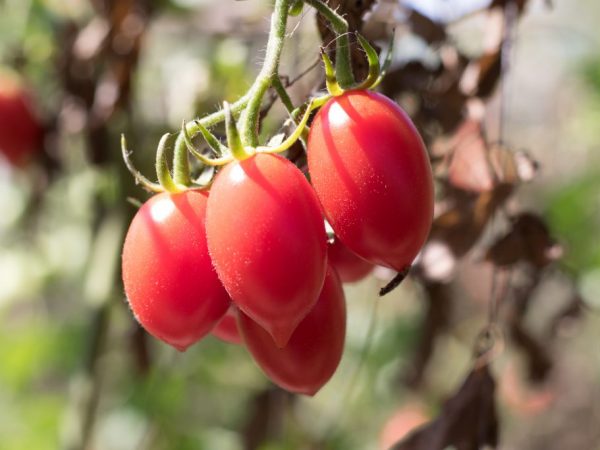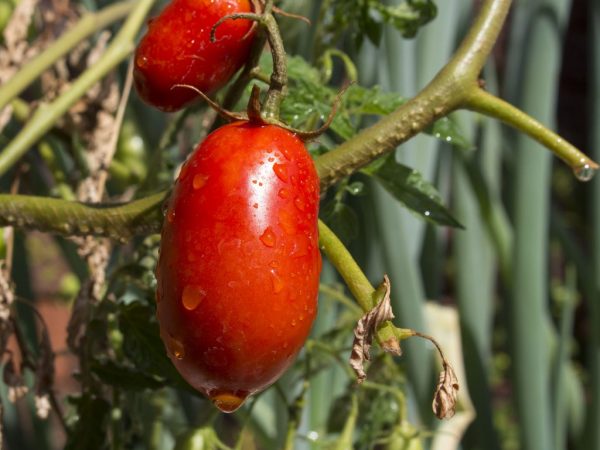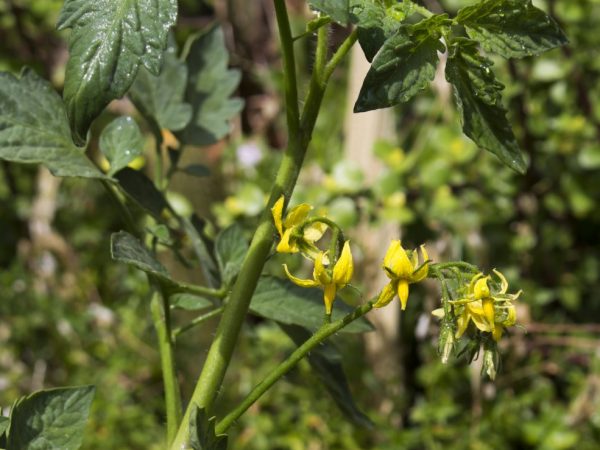Characteristics of the tomato variety Rio Fuego
Rio Fuego tomato has excellent taste and aroma. The thick peel on the fruit protects it from impacts, so it is not afraid of transportation, and is also universally suitable for pickles. Suitable for mechanical harvesting, which explains its high popularity.

Characteristics of the tomato variety Rio Fuego
Characteristic
Tomato Rio Fuego is determinant, medium-early ripeness. Tomatoes begin to ripen in the second decade of July and bear fruit until the very frost, bringing a good harvest.
Some vegetable growers believe that the fruit lacks juiciness, but this is easily compensated by good taste and unique aroma. The full characterization of the variety will convince readers that they should be interested.
Description of the variety
The variety is distinguished by high fertility, its selection belongs to the Dutch. The plant is short and compact, it does not require much space and area.
It is recommended to grow a tomato using a seedling method in open field conditions. Subject to all the conditions of agricultural technology, up to 15 kg of tomato can be obtained from each bush.
Description of the bush
The bush of this variety is medium, its height does not exceed 70 cm. The leaves are small, dark green in color.
When forming bushes, you need to leave several trunks, on each of which an ovary is formed. In this way, the yield of tomatoes is increased.
Description of fruits
The fruits ripen 4 months after sowing. Tomatoes have a high density, which is very convenient for transportation.
Characteristics of Rio Fuego fruits:
- oblong, cream-like, with a pointed nose;
- with a fairly dense pulp;
- small size, no more than 8 cm in length;
- saturated bright red color;
- average weight - 110 g.
The high concentration of sugar and excellent taste have made Rio Fuego tomatoes unusually popular, they can be eaten fresh and canned. The cost of Rio Fuego can be different, it depends on the size and presentation of the fruit.
Growing tomatoes

Change the place of planting the bushes annually
This variety can be grown immediately in open field conditions. It is important to choose a suitable place in the garden: it must be sunny, without drafts, well protected from the wind. The predecessors of tomatoes can be cucumbers, legumes, cabbage. It is unacceptable to grow plants for several years in a row in the same place, since larvae of pests of nightshade crops remain in the ground.
Planting seeds
Before planting seeds, you need to prepare the soil.
Soil preparation rules:
- Dig up a bed no more than 1.2 m wide (the optimal time is the end of April).
- For each square. m. add no more than half a bucket of humus and 0.5 liters of ash.
- In the garden, draw two grooves up to 10 cm deep, their distance from each other is about half a meter.
- The soil in the grooves should be disinfected with a weak solution of potassium permanganate.
- The bed needs to be wrapped in foil for a week so that it warms up.
After seven days, the garden bed is ready for sowing tomatoes, after that the film must be removed, in each groove, make recesses at a distance of 35-55 cm and sow tomato seeds (1-2 pcs.). The seeds should be sprinkled with earth, preferably with peat mass or sand.
Sowing is carried out in late April - early May, the earth is covered with a film, its edges are densely covered with earth, as a result of which the sprouts will be reliably protected from the night cold.
Sprout care
The first shoots appear in a week, when they reach the cover, it should be lifted with props, the ground around the plants is loosened. R
Benefits of sowing seeds in open ground:
- the seedless method forms a strong root system and excellent immunity in the sprouts: neither drought nor painful conditions are terrible for such tomatoes;
- plants do not experience stress during picking and replanting, therefore they bloom early and bear fruit;
- plant care is much easier than growing seedlings, and the result is much better.
In hot weather, the film must be lifted and ventilated. Tomatoes are hardened in this way and are not afraid of temperature changes.
Fertilizer
The first feeding should be done 3 weeks after sowing the seeds. It is not recommended to feed the sprouts until the first full-fledged leaf appears, since oversaturation with some substances can lead to a negative result. For the first feeding, it is recommended to use the following solution: 1 tbsp. a spoonful of fertilizer ("Nitrofoska", "Agricol No. 3") is diluted in 1 liter of water. The resulting solution is enough to fertilize about 35 plants.
After 14 days, fertilizers are applied again: if the tomato has a thin stem, a superphosphate solution should be used (1 tbsp. L. Fertilizer is diluted in 3 liters of water). You can use the "Athlete" preparation once for feeding. To fertilize healthy plants that meet all the necessary requirements, use "Effekton O".
Further fertilization of tomatoes is carried out every 20 days. Throughout the entire growing season of the plant, fertilizing is carried out up to 5 times, taking into account the fertility of the soil.
Watering

Abundant watering is required before the third brush of flowers appears.
The sprouts under the film are not watered, since there is enough moisture in the soil in spring, but if the spring is very early and warm, then the plants are carefully watered under the root with warm water in the morning or evening.
Plants should be watered abundantly until the third brush with flowers appears, otherwise the tomato will mobilize all forces for the development of the root system. As a result, the growth of fruits will be slowed down, and precious time will be lost, which may significantly reduce the yield.
Diseases
During the cultivation of tomatoes, vegetable growers may be faced with various painful conditions: twisted and yellowed leaves, drooping stem, blackened fruits. Diseases of tomatoes are provoked by:
- viruses;
- bacteria;
- various mushrooms;
- improper care or growing conditions;
- lack of trace elements.
Late blight is one of the most dangerous and widespread fungal diseases of tomatoes. This painful condition most often affects varieties of late ripeness, so Rio Fuego is very rarely sick with it.
Gray rot can damage tomatoes in high humidity and tillering plants. First, gray-brown spots appear on the leaves, then the stems and fruits are damaged. If the plant is not treated in time, it may die.
The characteristics of Rio Fuego indicate that he is resistant to attacks of Alternaria, verticillus, fusar wilt.
Prophylaxis
For the prevention of phytosporosis, plants need to be treated with fungicidal preparations (Fitosporin-M, Tatu, Ridomil Gold). For processing, a 10% solution of sodium chloride is also suitable (for 10 liters of water, 100 g of salt). In addition, the following rules must be observed:
- plant tomatoes near other nightshades, such as potatoes, which carry the disease;
- dig deep into the soil;
- remove affected leaves and plants;
- watering tomatoes at the root;
- use folk remedies (tincture of garlic).
When the first signs of gray rot appear, the plants should be treated with fungicides (Switch, Fundazol). In order to prevent the development of the disease, the following measures are taken:
- damaged areas on tomatoes should be greased with fungicide solutions or chalk;
- provide good ventilation of the plants - plant each other at the required distance.
It is necessary to promptly remove the affected fruits or plants, change the crops growing in the same bed. In case of frost, tomatoes should be covered overnight with foil or agrofibre.
Conclusion
As the description and reviews of gardeners show, Rio Fuego is an excellent choice for novice vegetable growers, since a tomato practically does not require a garter, it is simple in agricultural technology and care.
The ability to grow it immediately in open ground is an important advantage of this unpretentious variety. The shape and size of the fruits allows them to be used in salads, canned and salted. Dense tomato pulp and hard peel reliably protect the fruits from damage during transportation, they are excellent keeping quality. Anyone who has grown Rio Fuego tomatoes once will never be able to refuse them again.


